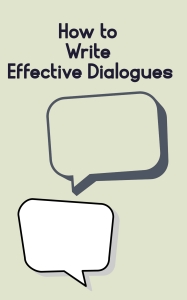
How to Write Effective Dialogues
Dialogue can be one of the most interesting parts of a story. There is just one caveat though- it needs to be done right! Sharpening your skills and challenging yourself to writing engaging dialogue is, therefore, key.
Effective dialogue needs to do many things besides simply conveying information. It can set a scene, advance action, give insights into the character, foreshadow dramatic action and lots more. To say that writing dialogue is hard work is an understatement.
Here are some handy tips to be able to write effective dialogues that keep the readers engaged:
#1 Keep it brief
While it may be tempting to use lengthy dialogues to reveal an important truth about the characters, their motivations and worldview, the fact remains that extremely lengthy dialogue can be exhausting for the reader and more often than not, may not be able to hold reader attention. Dialogues that go on for too long can start to feel like a tennis match with the reader switching back and forth between characters.
The thumb rule to follow when using dialogue is to include the kind that reveals something necessary about the character or moves the plot along. How is the weather? may not do much to move the plot.
#2 Keep it real
Abstain from using dialogues as a means to dump information on the reader. The question to ask yourself when in doubt, is if the conversation sounds real and if people talk or interact like this in real life.
#3. Ensure characters stay true to who they are
Whether it is the word choice or pattern of speech, use dialogues to reinforce characterization. It will help to give the character a unique way of speaking. It could be a sharp staccato or a flowy way of speaking; quick words or graceful phrasing to subtly reinforce the kind of character you have built. The CEO of a multibillion-dollar company would choose different words than a teenage girl. Consistency is definitely key. A shy, introvert wouldn’t suddenly become bold, unless of course there is a significant event that merits that change. Of course, you will need to honor the relationship as characters tend to speak differently based on who they’re speaking to. This offers more depth to the character.
#4 Minimize identifying tags
“She said, he said” is sure to bring in reader fatigue. Identifiers actually tend to take the reader out of the immersive experience of the story. While identifiers are important, limit their use by creating a unique pattern of speech for each character. The use of descriptive follow-ups can also break the monotony of identifiers.
#5 Show don’t tell
When writing dialogues it is easy to start telling what the characters are feeling as opposed to showing it. The key is not to get lazy with dialogue. Use it to reveal characters by all means, but not directly. Use of non-verbal cues, body language can be an interesting way to give reader important clues that they will use to recreate the scene in their minds. By including nonverbal details in your dialogue, you can articulate emotion through action.
To write dialogue that is effective, you must also pay adequate attention to formatting and style. Correct use of tags, punctuation, and paragraphs can be as important as the words themselves.
Here are a few simple rules:
Use Quotation Marks to Indicate Spoken Word
Whenever someone is speaking, their words should be enclosed in double quotation marks. Remember to keep dialogue tags outside the quotation marks. If the dialogue tag comes before the dialogue, the comma appears before the first quotation mark.
Example: “There was chaos everywhere,” Radhika explained.
Use a Separate Sentence for Actions That Happen Before or After the Dialogue
If an action occurs before or after the lines of dialogue, it should merit a new sentence.
Example: Manish sighed. “You’re going away?”
Use a New Paragraph to Indicate a New Speaker
Each time you change speakers, a new paragraph with an indent, is in order. This brings clarity to the reader.
Use Single Quotes When Quoting Something Within the Dialogue
If a character is quoting something or somebody else within their dialogue, use of single quotation marks indicate that the character is quoting someone else.
To Sum Up
You need to flex the dialogue-writing muscle to be able to create effective dialogue. Practice is key. It will help to keep a dialogue diary to practice speech patterns. Listening to people speaking and taking notes is yet another way to keep your dialogues real. Last, but definitely not the least, read as much as you can and benefit from the masters and their form and flow of dialogue!
About the Author







Comments